The following article was copied and pasted from my electronic subscription of Epoch Times.
To subscribe at $1 for two months and $9.99 per month thereafter, use the following link:
https://subscribe.theepochtimes.com/p/?page=digitalsub
[Movie trailer is at end of post]
‘The Ten Commandments’: At the Top of His Game: Cecil B. DeMille’s Triumph
“The Ten Commandments” (1956) has kept several generations of kids glued to the TV around Passover and Easter time, but Cecil B. DeMille’s epic is rarely taken seriously. Seen on a small screen, faded, panned and scanned, interrupted by toothpaste commercials, it can look pretty corny.
But a 2010 restoration revealed the film to be, for all its well-known flaws, as visually splendid as a medieval cathedral, created like a cathedral by a brilliant team of faith-inspired artists and craftsmen. Seen on a big screen or on Blu-ray, minus the toothpaste, the restored movie stakes a claim for itself as a major work of religious iconography, a populist Sistine Chapel.
Cecil B. DeMille (1881–1959) began in the theater, acting and writing. He shot his first movie in a rented barn: “The Squaw Man” (1914). Fame and success came quickly. In 1922, he invited fans to write in with suggestions for his next picture. The surprise winner was 1923’s “The Ten Commandments.”
DeMille and his scenarist concocted a two-part story. The first hour dealt with Moses and the Exodus, followed by a cautionary tale about a modern atheist whose scorn for religion leads to tragedy. The movie was a hit.
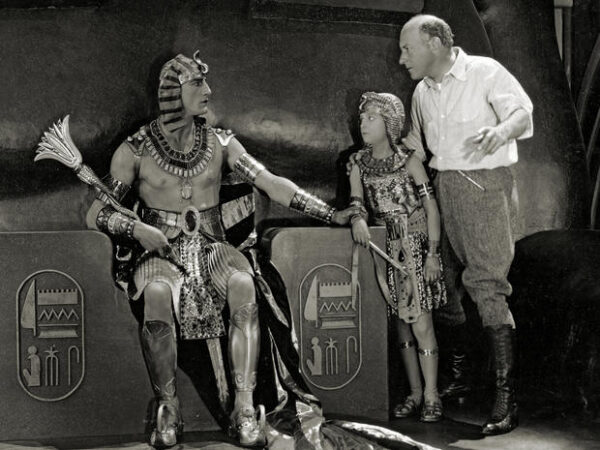

Decades and many films later, although slammed by critics and snubbed at the Oscars, DeMille was still on top, according to Scott Eyman’s book “Empire of Dreams.” Bad reviews didn’t stop his “Samson and Delilah” from becoming the highest-grossing movie of 1950. He followed it with an even bigger success: “The Greatest Show on Earth,” a backstage circus story. The cast included a young actor who’d appeared in only one other film: Charlton Heston.
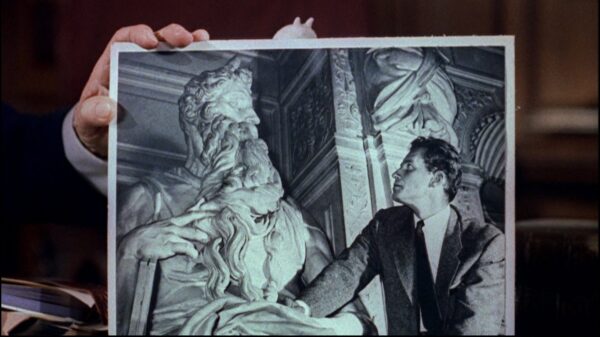
His Own Remake
In 1952, at an age when most directors have retired, DeMille was coming off two big hits. How could he top them? With an even bigger epic, of course: a remake of his own work “The Ten Commandments.”
The idea made Paramount executives nervous. Even with DeMille’s stellar track record, a new Bible film was risky, especially one without the sex appeal of “Samson and Delilah.” With the colossal spectacle audiences now expected from the director, and lots of special effects, the remake might cost more than anybody had ever spent on a movie. (Spoiler alert: It did.)
In the 1923 version, the modern story was a letdown after the exciting Exodus scenes, so DeMille eliminated it. Since the Bible tells us nothing about Moses from his babyhood to age 30, the script added stories from other ancient Jewish and Christian sources. It also added a DeMille staple: Two men in love with the same woman. To make this work, Moses couldn’t be cast as the earlier film had, as an elderly patriarch. He had to be young and virile: Charlton Heston.
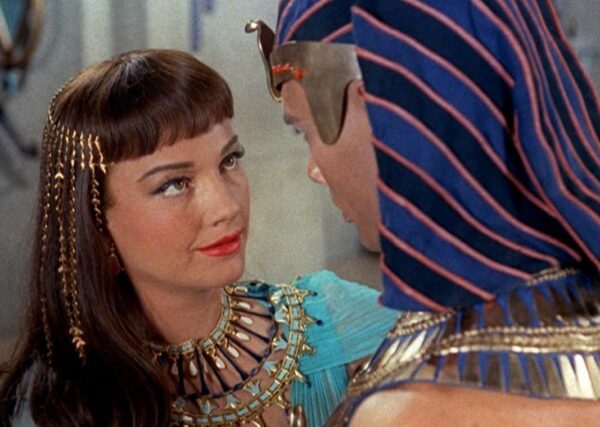
The film’s acting and writing are often called stilted, but its grand, historical scope demanded larger-than-life performances and dialog that wouldn’t sound too modern. The movie’s forthright, declarative style, reinforced by Elmer Bernstein’s powerful music, recalls the Victorian dramas of DeMille’s youth—with all primary colors and no shades of gray.
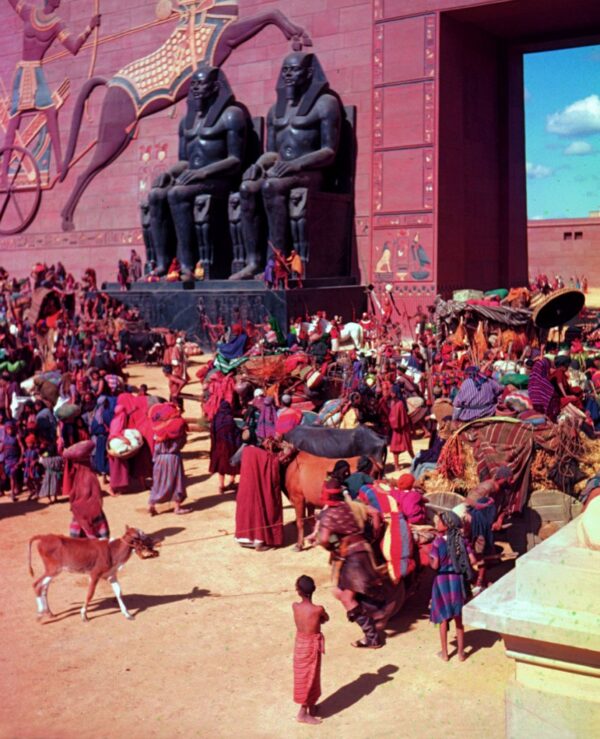
For the seductive princess Nefretiri (not to be confused with Nefertiti, who reigned a century earlier), DeMille wanted Audrey Hepburn, but her figure, perfect for Givenchy, was too slim to fill out the clinging gowns, so Anne Baxter got the part. She wasn’t ideal either, not quite credible as a temptress and prone to chewing scenery, but she’s not bad. Other roles went to Vincent Price, Yvonne De Carlo, Edward G. Robinson, and Judith Anderson.
Scene Stealer Brynner as Rameses
Heston’s sonorous voice and stalwart demeanor served him well as Moses, the first of many historical heroes he would play on the screen, but it’s Yul Brynner as the pharaoh Rameses who really steals the movie. Rarely has an actor fit a part so perfectly. In ancient Egypt, nobles shaved their heads; Brynner already did. Though actually Russian, his exotic masculinity, piercing gaze, and indefinable accent are so right for Rameses that it’s hard to imagine another actor in the role. Brynner rocks his flashy outfits and glittering regalia as if born to wear them. Even his ripped physique is an asset, since Rameses is shirtless for much of the movie.
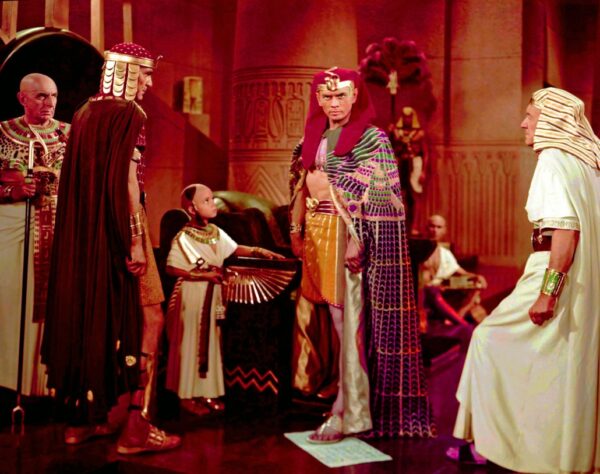
Back in 1927, H.B. Warner had played Jesus in DeMille’s favorite of all his films, “The King of Kings.” By the 1950s, the actor was dying, forgotten in a nursing home. DeMille wanted him so badly to play the old blind man who can’t walk but offers a tree to plant in the Promised Land, he sent an ambulance to pick him up. When Warner was too weak to finish his lines (taken from Psalm 22), DeMille let him say as much as he could: “I am poured out like water. My strength is dried up to the dust of death,” Eyman reports. It was Warner’s last role and one of many occasions when the director remembered and showed kindness to people who had worked for him, even decades before.
In his career, DeMille peddled plenty of hokum, but for this film he insisted on historical accuracy. For three years, his team accumulated research that was later published as a book. No detail was overlooked. According to film scholar Katherine Orrison, blue-eyed cast members had to wear brown contact lenses. Even the scrap of cloth that proves Moses is the son of slaves was woven “on authentic looms of the period … using the same dyes … and the pattern that represented the Levite tribe.”
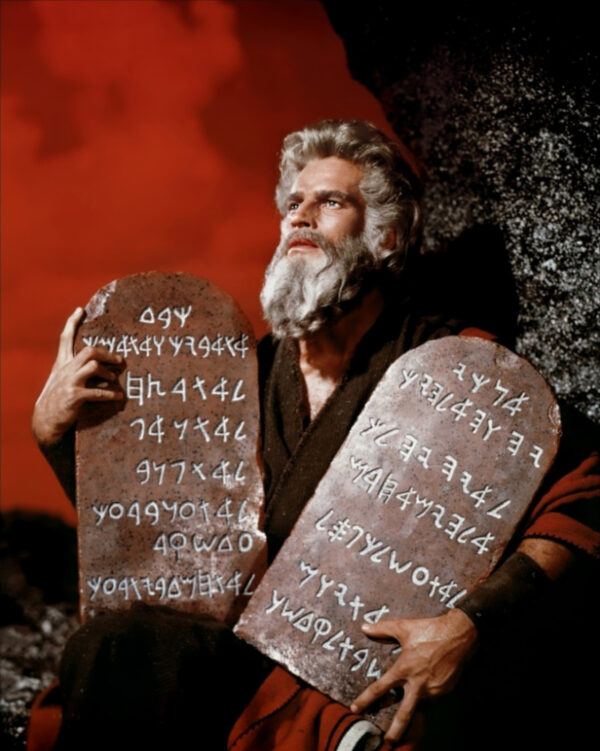
Eye-Popping Visuals
Visually, “The Ten Commandments” is magnificent. All of art history flows through its beautiful images. Every ornate costume, set, and prop contributes to DeMille’s meticulous, pageant-like storytelling. Every scene, carefully composed in Technicolor’s gem-like hues, seems to evoke a Renaissance painting.
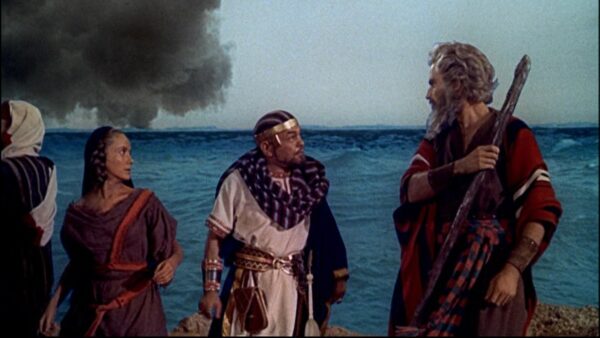
When it comes to spectacle, DeMille outdid himself. The flight out of Egypt, the raising of the obelisk, the revelation on Mt. Sinai, and of course the parting of the Red Sea are unforgettable. The big scenes team with thousands of extras and animals. How did the director find so many actors on location in Egypt? President Nasser, remembering DeMille’s respectful treatment of the Saracens in “The Crusades” (1935), put the entire Egyptian army at his disposal.
Steven Spielberg called the movie’s Red Sea scene “the greatest special effect in film history,” reports Emanuel Levy on his website Cinema 24/7, but it’s marred by black lines (called fringing) around the picture elements. Granted, it was 1956, but that wasn’t the problem. The premiere date was set, so there wasn’t time to fix or even finish the effects, not even the lackluster burning bush that DeMille hated when he saw it.
“The Ten Commandments” was DeMille’s last, most expensive, and most successful production. He gave his heart and soul to it, and almost his life. Eyman explains that while filming the tremendous Exodus scene and inspecting a camera high atop a tower, the 74-year-old director suffered a massive heart attack. Told by his doctors to rest in bed for a month on oxygen, he replied: “Forget it, gentlemen!” He was back on the set the next morning.
In a spoken prologue cut from the film on television, DeMille calls his movie “the story of the birth of freedom.” He asks, “Are men the property of the state, or are they free souls under God?” That indeed is the question. After 66 years, “The Ten Commandments” remains, perfectly imperfect, a testament to what Hollywood achieved and could achieve again, motivated by faith, freedom, and tradition.


